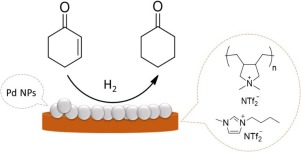Applied Catalysis A: General ( IF 5.5 ) Pub Date : 2018-06-01 , DOI: 10.1016/j.apcata.2018.06.001 Nathália M. Simon , Gabriel Abarca , Jackson D. Scholten , Josiel B. Domingos , David Mecerreyes , Jairton Dupont

|
The structural, electronic and support effect on palladium nanoparticles (Pd NPs) prepared by sputtering deposition and chemical reduction of a Pd(II) precursor in/on a poly(ionic liquid) (PIL) was investigated in the selective hydrogenation of α,β-unsaturated carbonyl compounds and dienes. Sputtering deposition generates naked NPs with a narrow size distribution (3.2–3.8 nm) that are predominantly composed of Pd(0) (85–100%). Conversely, chemical reduction produces PIL-covered NPs with almost twice the average size (6.6 nm) and only 15% Pd(0). Regard the catalytic performance, support composition (by ionic liquid (IL) addition or not) and NP location are decisive. The best activity and selectivity was obtained with imprinted Pd NPs on a PIL/IL mixture (D-MPIL.NTf2/IL-Pd catalyst). A kinetic investigation was conducted using 2-cyclohexen-1-one (CHN) and D-MPIL.NTf2/IL-Pd catalyst revealing that this reaction follows the Langmuir-Hinshelwood mechanism. Enthalpies obtaining from a Van't Hoff plot show that the adsorption of the CHN substrate on the surface of the PIL-Pd catalyst is an exothermic process (-9 kJ mol−1), whereas H2 adsorption occurs by an endothermic process (12 kJ mol−1). This distinct behavior is consistent with the rate determining step proposed, in which the independent adsorption of reagents is followed by the hydrogenation of a π-allyl intermediate on the catalyst surface.
中文翻译:

聚离子液体上负载的钯纳米粒子的结构,电子和催化性能
在α,β选择性加氢中,研究了通过溅射沉积和化学还原Pd(II)前体在聚离子液体(PIL)中/之上对钯纳米颗粒(Pd NPs)的结构,电子和支持作用。 -不饱和羰基化合物和二烯。溅射沉积会生成裸露的NP,其粒径分布较窄(3.2–3.8 nm),主要由Pd(0)(85–100%)组成。相反,化学还原产生的PIL覆盖的NP几乎是平均大小(6.6 nm)的两倍,而Pd(0)仅为15%。关于催化性能,载体组成(是否通过离子液体(IL)添加)和NP位置是决定性的。在PIL / IL混合物(D-MPIL.NTf 2/ IL-Pd催化剂)。使用2-环己烯-1-酮(CHN)和D-MPIL.NTf 2 / IL-Pd催化剂进行了动力学研究,表明该反应遵循Langmuir-Hinshelwood机理。从Van't Hoff图获得的焓表明,CHN底物在PIL-Pd催化剂表面的吸附是放热过程(-9 kJ mol -1),而H 2吸附是通过吸热过程发生的(12 kJ mol -1)。这种不同的行为与提出的速率确定步骤一致,在该速率确定步骤中,试剂的独立吸附之后是催化剂表面上的π-烯丙基中间体的氢化。



























 京公网安备 11010802027423号
京公网安备 11010802027423号